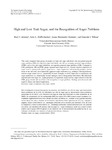Mostrar el registro sencillo del ítem
High and low trait anger, and the recognition of anger problems
| dc.date.issued | 2015-05-21 | |
| dc.identifier.issn | 1138-7416 | |
| dc.identifier.uri | http://hdl.handle.net/20.500.11777/980 | |
| dc.description.abstract | This study compared three groups of people: (a) high trait anger individuals who recognized personal anger problems (HR); (b) high trait anger individuals who did not recognize personal anger problems (HNR); and (c) low trait anger individuals not reporting personal anger problems (LNR). Compared to LNR participants, HR and HNR groups reported more anger-out (i.e., outward negative expression of anger such as arguing with others), anger-in (i.e., anger suppression and harboring grudges), greater desire to use and actual use of physically aggressive anger expression (e.g., pushing or shoving someone), and less anger control-in (i.e., emotionally focused strategies to lower anger such as relaxation) and anger control-out (i.e., behaviorally focused strategies such as being patient with others). HR individuals reported more trait anger (i.e., higher propensity to experience anger) and less anger control-out than the HNR group. Gender did not relate to the recognition of anger problems. Findings were discussed with regard to theory and clinical implications. | en_US |
| dc.language.iso | Inglés | en_US |
| dc.subject | Anger | en_US |
| dc.subject | Recognition | en_US |
| dc.subject | Trait anger | en_US |
| dc.subject | STAXI | en_US |
| dc.title | High and low trait anger, and the recognition of anger problems | en_US |
| dc.type | Artículo | en_US |
| dc.contributor.author | Alcázar Olán, Raúl José | |
| dc.contributor.author | Deffenbacher, Jerry Lee | |
| dc.contributor.author | Hernández Guzmán, Laura | |
| dc.contributor.author | Wilson, Graciela | |
| dc.date.accessioned | 2015-05-21T21:54:40Z | |
| dc.date.available | 2015-05-21T21:54:40Z |

